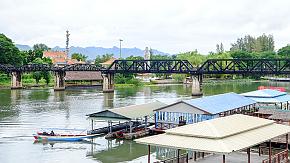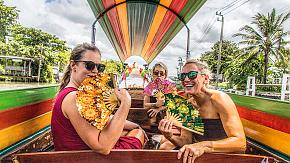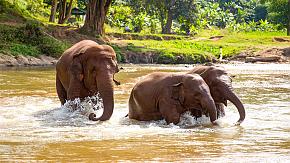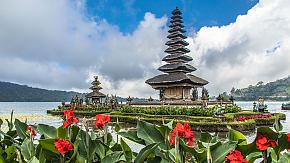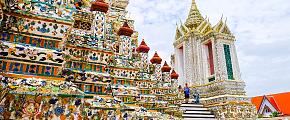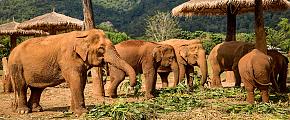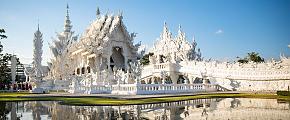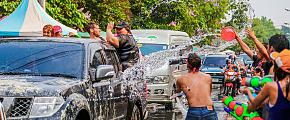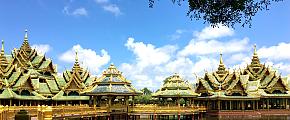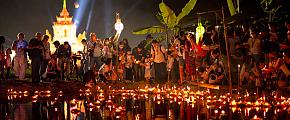Travel Around Kanchanaburi: A Complete Guide
Kanchanaburi is known as one of the most beautiful places in Thailand and is about 3 hours from Bangkok. In addition to the Death Railway and the River Kwai Bridge, which are famous for their association with World War II, Kanchanaburi also boasts the stunning Erawan Waterfall, Wat Tham Sua, and many idyllic restaurants and riverside hotels. Here you will find an introduction to these tourist features of Kanchanaburi and suggestions on how to get to Kanchanaburi, how many days you need to travel and the best time to visit.
Highlights in Kanchanaburi
1. Thai-Burma Railway (Death Railway)
The Thai-Burma Railway was built during World War II and is 258 miles long, connecting Thailand and Myanmar (Burma). The Japanese forced allied prisoners of war and laborers to work day and night to build this railway to transport supplies. Due to the treacherous terrain, harsh living conditions and Japanese atrocities, tens of thousands of people died during the construction of the Thai-Burma Railway, so it is also known as the Death Railway. The section from Thonburi in Bangkok to Nam Tok in Kanchanaburi is still in operation, including the famous River Kwai Bridge and Tham Krasae Bridge.
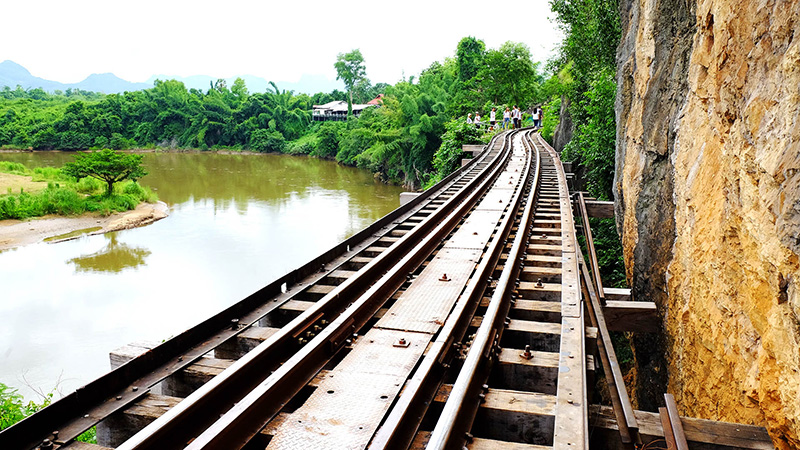 Thai-Burma Railway
Thai-Burma Railway
River Kwai Bridge
The magnificent River Kwai Bridge is a landmark section of the Death Railway, spanning the river and with the treacherous peaks at one end. The story of its construction was made into a movie, The Bridge on the River Kwai, released in 1957, which won seven Oscars, including Best Picture, and made the bridge more known to the world. Today, the River Kwai Bridge, which had been renovated, allows people to cross it on foot, taking about 10 minutes.
Standing on the bridge, in front of you, the River Kwai sparkles and flows gently, and sometimes there are small boats carrying tourists slowly approaching; in the distance, the green hills stretch, and the countryside is poetic and quiet. When trains come across, they slow down and sound their whistles early on, and visitors can stand at the platforms set up on the bridge to get a closer glimpse of the trains crossing the bridge. You can check the train schedule of the day and wait in advance. For a panoramic view of the bridge, you can stand in the open space at either end of the bridge or rent a long-tailed boat to watch it on the river. The white piers, shiny black arches and straight rails outline this sturdy steel bridge. You can walk across the River Kwai Bridge at any time, it is open 24 hours a day, but it's still recommended to go in the daytime because it's safer to walk on the bridge in a better light.
If you want to experience the River Kwai Bridge by train, you can take the route starting at Thonburi station in Bangkok and ending at Nam Tok station in Kanchanaburi, which has many stations along the way, and you can freely choose where to get on the train. The closest to River Kwai Bridge is the River Kwai Bridge station (about 200 meters from the bridge). If you are departing from Bangkok's Thonburi station, it takes about 3 hours to reach River Kwai Bridge. There are usually several trains between 7 am and 6 pm, and please check the train schedule for the day, which may change. The trains retain their old carriages, and the clanking of wheels against the track makes it a fun experience. Note that the carriages can sway a bit, so for safety reasons, stay away from the doors. The trains pass by beautiful villages, rivers and woods, and you will take many wonderful photos.
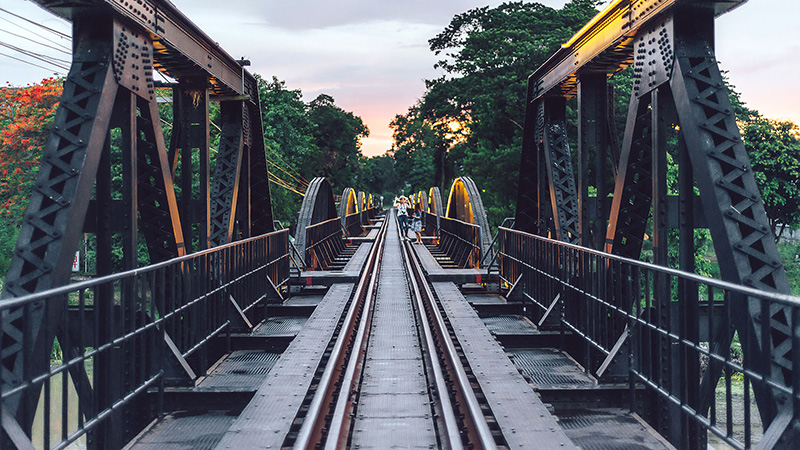 River Kwai Bridge
River Kwai Bridge
Don-Rak War Cemetery (Kanchanaburi War Cemetery)
The Don-Rak War Cemetery contains the graves of 6,982 Allied prisoners of war who died in the construction of the Death Railway. The neatly arranged rows of headstones are surrounded by tropical flowers and level lawns. As the largest war cemetery in Kanchanaburi, it is a quiet place away from the hustle and bustle, and many visitors come here to pay their respects by laying flowers. Don-Rak War Cemetery is right next to Kanchanaburi station, which is also on the railway route from Thonburi to Nam Tok, and is the previous stop of the River Kwai Bridge station. The Don-Rak War Cemetery is open 24 hours a day.
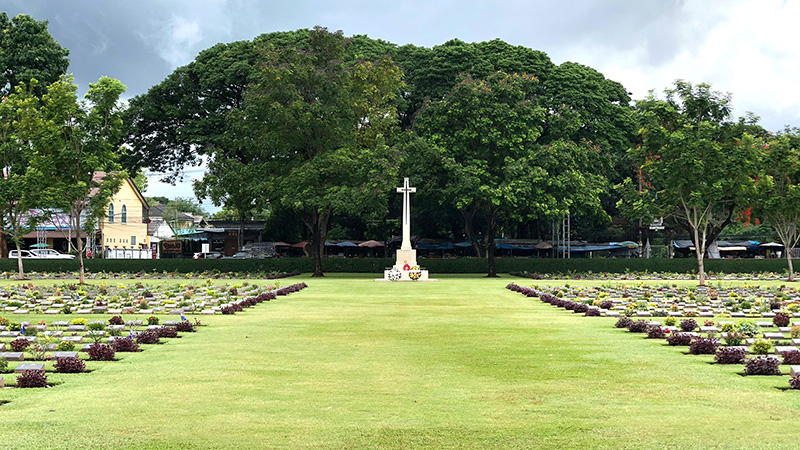 Don-Rak War Cemetery
Don-Rak War Cemetery
Tham Krasae Bridge
After the River Kwai Bridge, the railway extends into the mountains and forests. The most thrilling section is the Tham Krasae Bridge, 450 meters long, built on a cliff with the River Kwai below. This section can also be crossed by train or on foot, and the track is very high, making it very exciting to either take the train or walk on it. If you are crossing it on foot, which takes about 10 minutes, watch out for approaching trains. There are several trains passing every day, and they travel slowly, but please also back up to the open space outside the bridge as soon as possible.
To get to Tham Krasae Bridge, it is not necessary to pass River Kwai Bridge first, you can just wait for the train at Tham Krasae station next to Tham Krasae Bridge. Tham Krasae Bridge allows visitors to walk on it usually between 8 am and 5 pm. Trains passing through here are usually between 7 am and 6 pm, and please check the train schedule for the day.
Hellfire Pass (Konyu Cutting)
The Hellfire Pass (Konyu Cutting) was the most difficult section of the entire Death Railway to build, requiring the cutting of mountains. At night, the scene of skinny prisoners of war and laborers working with rudimentary tools under the light of fire looked no different from the torture in hell, hence the name of this section.
Now, Hellfire Pass has been changed into a walking trail, and at its beginning there is the Hellfire Pass Memorial Museum, built by the Australian and Thai governments, which does not charge admission and has donation boxes where visitors can donate as they wish. The museum exhibits background information on the Death Railway, a model of the Hellfire Pass, tools used during the construction of the railway, items from prisoners of war, film presentations, etc.
You can walk from the Hellfire Pass Memorial Museum to the Konyu Cutting monument and then walk back, which is a very impressive way to see the valley cut by rudimentary tools, and the trail is relatively flat and takes about an hour for a round trip. The train does not pass through Hellfire Pass, you can take the train to Nam Tok station and then take a bus there for about 15 minutes to reach Hellfire Pass. Hellfire Pass and Hellfire Pass Memorial Museum are open daily from 9 am to 4 pm and usually take a total of 3 hours to visit.
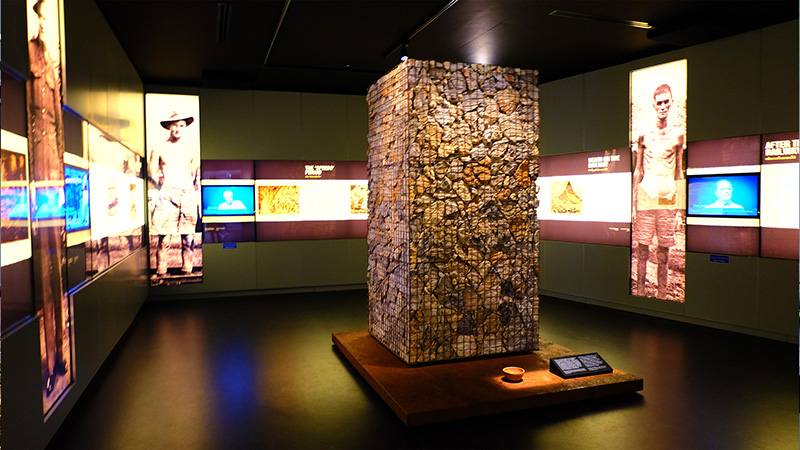 Hellfire Pass Memorial Museum
Hellfire Pass Memorial Museum
2. Wat Tham Sua
Wat Tham Sua, the most famous temple in Kanchanaburi, is located on top of a hill. The temple boasts a magnificent and awe-inspiring 18-meter-high golden Buddha. Many locals and tourists come here to pray for good fortune. Climbing the nine-story pagoda next to the Buddha offers a great view of the stunning scenery of the rice fields surrounding the temple.
It takes about 25 minutes to reach the foot of the temple by taxi from River Kwai Bridge. To enter the temple, you need to climb stairs (about 10 minutes) or take a cable car. The temple is open daily from 8 am to 5 pm and usually takes 1 to 2 hours to visit.
3. Giant Raintree
Giant Raintree, which is more than 100 years old, is umbrella-shaped, about 20 meters tall, with branches stretching about 52 meters and a trunk that takes 10 people to encircle. The tree's branches flourished and its roots broke through the soil to show its amazing vitality. The moment you see it, you will feel like walking into a movie. Under the tree, there is a circular wooden walkway, where residents will take a walk and cool off. You can join them to experience the relaxing atmosphere under the shade of this century-old tree and take beautiful photos of the tree from various angles, and of course you need to stand far enough to take a panoramic view.
Giant Raintree is located in the Royal Thai Army's Division of Veterinary and Agriculture, which is open from 8:30 to 16:30 Monday to Friday and 08:30 to 17:00 on Saturday and Sunday. You can take a taxi there and follow the signs to Giant Raintree. Visitors usually stay there for about 1 to 2 hours.
4. Erawan Waterfall
Erawan Waterfall has seven interconnected tiers of waterfalls in a stepped pattern, with trails next to the waterfalls where you can climb from the first to the seventh tier, and the water gets clearer as you go up. You can swim in the pools formed by the waterfalls, or walk through the forest trails around to enjoy the natural beauty. The trails are slightly steeper from the fifth tier up, so visitors with children and the elderly are advised to stay on tiers 1 to 5. Those who are up for a challenge can hit all seven tiers in one go.
It is recommended to bring swimsuits, waterproof backpacks, towels, sunscreen, etc. Erawan Waterfall is open daily from 08:00 to 16:30 and can be reached by bus from Kanchanaburi bus station in about an hour. Visitors usually spend about 3 hours at Erawan Waterfall.
What to Eat in Kanchanaburi
Kanchanaburi's cuisines are mainly made of fish, pork and vegetables with Thai curry sauce or chutney, accompanied by fresh juices and delicious desserts. Famous restaurants are mainly concentrated around River Kwai Bridge.
Blue Rice Restaurant by Apple & Noi is located about 6 minutes drive from River Kwai Bridge and offers the gaeng tae poe made of morning glory, tender pork and sour red curry, as well as the famous pad Thai made of fine rice noodles stir-fried with tofu, dried shrimp, garlic, and egg, mixed with spicy-sweet sauce, crushed peanuts, and bean sprouts. Keeree Tara is about a two-minute walk from the River Kwai Bridge and offers a great view of the river, and the most recommended cuisines include redtail catfish with curry sauce, tom yum spicy shrimp soup and egg wrap with green curry.
Keeree Mantra Kanchanaburi is an idyllic restaurant surrounded by a huge green lawn, with coconut milk fish curry, pineapple fried rice, tom yum and cappuccino being very popular, and the restaurant is about 10 minutes drive from River Kwai Bridge. The Village Farm To Café is located next to Keeree Mantra Kanchanaburi, a wooden modern café surrounded by mountains and boasting a bamboo tunnel for customers to take a walk, with its melon cream chocolate bun and green melon frozen yogurt being highly recommended, a very good place to enjoy both food and photography.
Where to Stay in Kanchanaburi
It is highly recommended to stay in Mueang Kanchanaburi District in the south of Kanchanaburi, where most of the attractions and famous restaurants are concentrated, and most of the hotels here have beautiful river and mountain views. U Inchantree Kanchanaburi is located about 300 meters from the River Kwai Bridge, such a great location that you can enjoy the view of the River Kwai Bridge while sitting in the hotel's garden, restaurant, and bar. The hotel has bicycles for rent and it is a great experience to ride along the banks of the river to enjoy the scenery. It also has easy access to several famous restaurants, as it is 2 minutes walk from Keeree Tara and 8 minutes drive from Blue Rice Restaurant by Apple & Noi. Cross River Kwai is about a 20-minute drive from the River Kwai Bridge. It has 180-degree river views and a tranquil and idyllic setting, a restaurant with outdoor decks, The Bridge Bar & Bistro, and organized water activities such as paddle boating and kayaking.
How to Get to Kanchanaburi
There is no airport in Kanchanaburi, so if you are coming from abroad, you will need to fly to the nearest Suvarnabhumi Airport or Don Mueang Airport in Bangkok and then take a taxi (takes about 3 hours) or train to Kanchanaburi. If you want to take the train, you can go to Thonburi train station from Suvarnabhumi Airport or Don Mueang Airport by taxi (both take about 35 minutes) and then take the route that ends at Nam Tok train station. This route contains the best sections of the Death Railway and takes you about 3 hours to reach Kanchanaburi train station. The old-fashioned Thai-style carriages and the beautiful view of countryside, mountains and rivers along the way will leave you with an unforgettable memory.
How Many Days to Spend in Kanchanaburi
Please set aside at least two days so that you can visit the most popular attractions such as River Kwai Bridge and Tham Krasae Bridge. If you have enough time, why not stay for 4 to 5 days, with other attractions such as Wat Tham Sua, Erawan Waterfall, and Giant Raintree all being wonderful places to go. You can also enjoy lots of Thai food such as pad Thai, gaeng tae poe, tom yum, and take a long-tail boat or bike ride to explore River Kwai and the surrounding poetic villages and breathtaking mountains. You will live each day to the fullest.
Best Time to Visit Kanchanaburi
The best time to visit most attractions in Kanchanaburi is from November to March, when the weather is cooler and it doesn't rain much. Visiting the major attractions such as River Kwai Bridge and Tham Krasae Bridge is safer on sunny days with dry ground. If you visit Kanchanaburi from April to June, please take precautions against the heat, as the maximum temperatures during these months are usually above 35 degrees Celsius. June to October, though the rainy season in Kanchanaburi, is the best time to visit Erawan Waterfall, when the pools are filled with water and the curtains of water falling straight down are quite spectacular.
Explore Kanchanaburi with Odynovo
Kanchanaburi is a quiet tourist destination in Thailand, free from the heavy traffic and crowds, and has special historical value, while being scenic and poetic. Don't miss such a lovely place! Let Odynovo create travel plans and handle possible hassles for you, so you can enjoy your Thailand tour to the fullest.
Related Posts You May Like
What Our Clients Say
Explore the latest verified reviews of Odynovo's travel services on Tripadvisor, Google, Trustpilot, Product Review and more trusted platforms.

